 W
WA bottle is a narrow-necked container made of an impermeable material in various shapes and sizes to store and transport liquids and whose mouth at the bottling line can be sealed with an internal stopper, an external bottle cap, a closure, or a conductive "inner seal" using induction sealing. Some of the earliest bottles appeared in China, Phoenicia, Crete, and Rome.
 W
WThis is a list of bottle types, brands and companies. A bottle is a rigid container with a neck that is narrower than the body, and a "mouth". Bottles are often made of glass, clay, plastic, aluminum or other impervious materials, and are typically used to store liquids. The bottle has developed over millennia of use, with some of the earliest examples appearing in China, Phoenicia, Rome and Crete. Bottles are often recycled according to the SPI recycling code for the material. Some regions have a container deposit which is refunded after returning the bottle to the retailer.
 W
WAn aluminum bottle is a bottle made of aluminum. In some countries, it is also referred to as a bottlecan. It is a bottle made entirely of aluminium that holds beer, soft drinks, wine, and other liquids.
 W
WAn amphora is a type of container with a pointed bottom and characteristic shape and size which fit tightly against each other in storage rooms and packages, tied together with rope and delivered by land or sea. The size and shape have been determined from at least as early as the Neolithic Period. Amphorae were used in vast numbers for the transport and storage of various products, both liquid and dry, but mostly for wine. They are most often ceramic, but examples in metals and other materials have been found. Versions of the amphorae were one of many shapes used in Ancient Greek vase painting.
 W
WA baby bottle, or nursing bottle, or feeding bottle, is a bottle with a teat to drink directly from. It is typically used by infants and young children, or if someone cannot drink from a cup, for feeding oneself or being fed. It can also be used to feed non-human mammals.
 W
WA beer bottle is a bottle designed as a container for beer. Such designs vary greatly in size and shape, but the glass commonly is brown or green to reduce spoilage from light, especially ultraviolet.
 W
WThe Benewah Milk Bottle is a landmark in Spokane, Washington. Listed on the National Register of Historic Places, there are two constructed milk bottle-shaped buildings in the Spokane area, which accompanied a successful dairy operation's stores. One of the buildings is located on South Cedar Street in the Central Business District, while the other is located two miles north in the Garland Historical District.
 W
WA bota bag is a traditional Spanish liquid receptacle, used mainly as a wineskin. It is often made out of leather, and is typically used to carry wine, although any liquid can be filled into it. Often referred to as a canteen.
 W
WA bottle cap or bottle top seals the top opening of a bottle. A cap is typically colourfully decorated with the logo of the brand of beverage. Plastic caps are used for plastic bottles, while metal with plastic backing is used for glass; plastic caps are commonly made from PE or PP, whilst metal caps are usually either steel or alumnium .Plastic caps may have a pour spout. Flip-Top caps like Flapper closures provide controlled dispensing of dry products. Caps for plastic bottles are often made of a different type of plastic from the bottle.
 W
WA bottle crate or beverage crate is a container used for transport of beverage containers. In the present day they are usually made of plastic, but before the widespread use of plastic they tended to be made of wood or metal.
 W
WA bottle opener is a device that enables the removal of metal bottle caps from glass bottles. More generally, it might be thought to include corkscrews used to remove cork or plastic stoppers from wine bottles.
 W
WA bottle wall is a wall made out of glass or plastic bottles and binding material.
 W
WThe Bottle is a community located in the northern corporate limits of Auburn, Alabama, United States. The Bottle is located at the intersection of U.S. Highway 280 and Alabama Highway 147, five miles (8 km) north of downtown Auburn, and adjacent to the Auburn University North Fisheries Research Complex.
 W
WCalabash, also known as bottle gourd, white-flowered gourd, long melon, New Guinea bean and Tasmania bean is a vine grown for its fruit. It can be either harvested young to be consumed as a vegetable, or harvested mature to be dried and used as a utensil. When it is fresh, the fruit has a light green smooth skin and white flesh.
 W
WCarinate is a shape in pottery, glassware and artistic design usually applied to amphorae or vases. The shape is defined by the joining of a rounded base to the sides of an inward sloping vessel. This design is seen in ancient cultures such as recovered in archaeological digs in such sites as the palace of Knossos in Minoan Crete. An alternative adjectival form of this design is carinated.
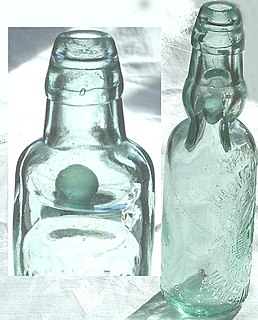 W
WA Codd-neck bottle is a type of bottle used for carbonated drinks. It has a closing design based on a glass marble which is held against a rubber seal, which sits within a recess in the lip.
 W
WThe crown cork, the first form of bottle cap, was invented by William Painter in 1892 in Baltimore. The company making it was originally called the Bottle Seal Company, but it changed its name with the almost immediate success of the crown cork to the Crown Cork and Seal Company. It still informally goes by that name, but is officially Crown Holdings. Crown corks are similar to the Pilfer proof caps, as usage of both products is to seal the bottle.
 W
WThe Fizz Keeper is a device that is sold as a means for preserving the carbonation in soft drinks. It comprises a small hand pump that screws onto the top of a plastic soft drink bottle, which is used to pump air into the bottle. Pressurizing the bottle in this way, it is claimed by most of those who sell the device, prevents the drink from going flat.
 W
WA flacon is a small, often decorative, bottle. It has an opening seal or stopper and is designed to hold valuable liquids which may deteriorate upon contact with the air. They are widespread in the food industry, the pharmaceutical industry and the cosmetics industry. They are generally made of glass for perfumes, but can also be made out of plastics for other uses.
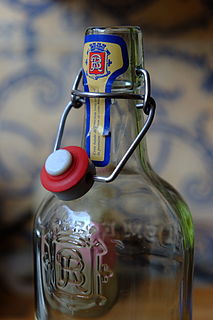 W
WA flip-top, swing-top, or Quillfeldt stopper is a type of closure frequently used for bottles containing carbonated beverages, such as beer or mineral water. The mouth of the bottle is sealed by a stopper, usually made of porcelain or plastic, fitted with a rubber gasket and held in place by a set of wires. The bottle can be opened and resealed repeatedly and without the use of a bottle opener, with the wires acting in the same way as a latch clamp. The flip-top was the dominant method of sealing beer and mineral water bottles prior to the invention of the crown cork.
 W
WThe Glass House, built by David H. Brown, is located on the east shore of Kootenay Lake in British Columbia near the rural locality of Boswell, British Columbia. Construction started in 1952 in order to, according to a quote left by Mr. Brown, "indulge a whim of a peculiar nature". Intended to be the Browns' home, the unusual construction and fantasy-castle appearance attracted traffic from the adjacent British Columbia Highway 3A. The resulting loss of privacy led to the Browns' establishment of a roadside attraction in the summer months.
 W
WGourds include the fruits of some flowering plant species in the family Cucurbitaceae, particularly Cucurbita and Lagenaria. The term refers to a number of species and subspecies, many with hard shells, and some without. One of the earliest domesticated types of plants, subspecies of the bottle gourd, Lagenaria siceraria, have been discovered in archaeological sites dating from as early as 13,000 BCE. Gourds have had numerous uses throughout history, including as tools, musical instruments, objects of art, film, and food.
 W
WGrandma Prisbrey's Bottle Village, also known as Bottle Village, is an art environment, located in Simi Valley, California. It was created by Tressa "Grandma" Prisbrey (1896–1988) from the 1950s to the 1970s. Prisbey built a "village" of shrines, walkways, sculptures, and buildings from recycled items and discards from the local landfill.
 W
WA growler is a glass, ceramic, or stainless steel bottle used to transport draft beer in the United States, Canada, Australia, Brazil and other countries. They are commonly sold at breweries and brewpubs as a means to sell take-out craft beer. Rarely, beers are bottled in growlers for retail sale. The significant growth of craft breweries and the growing popularity of home brewing has also led to an emerging market for the sale of collectible growlers. Some U.S. grocery stores, convenience stores, bars and restaurants have growler filling stations.
 W
WThe Guaranteed Pure Milk bottle is a landmark water tower in Montreal, Quebec, Canada, located at 1025 Lucien L'Allier Street. The 6-tonne (13,000 lb), 10-metre (33 ft)-high Art Deco structure was designed in 1930 by architects Hutchison, Wood & Miller as advertising for the Guaranteed Pure Milk Company. The building on which it stands is the former headquarters of the Guaranteed Pure Milk Company and is visible in the movie "Red 2" as the exterior of the "Yankee White Facility", although the water tower itself is not.
 W
WA hip flask is a thin flask for holding liquor.
 W
WThe Historical Museum of the Palatinate is a museum in the city of Speyer in the Palatinate region of the German state of Rhineland-Palatinate. It is situated across the square from the Speyer Cathedral. The museum's focus is on the History of the Palatinate; it has a collection of about 1 million artifacts, the oldest being an approximately 190,000-year-old hand axe. The museum is among the most important in Germany, and is known for its special exhibitions. With over 200,000 visitors per year it is one of the major attractions of Speyer.
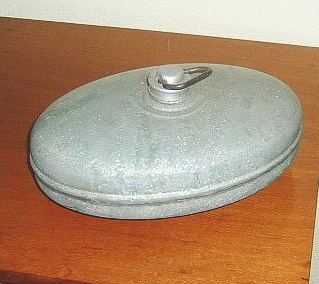 W
WA hot-water bottle is a bottle filled with hot water and sealed with a stopper, used to provide warmth, typically while in bed, but also for the application of heat to a specific part of the body.
 W
WAn impossible bottle is a bottle containing an object that does not appear to fit through the bottle's mouth.
 W
WThe Milk Bottle Grocery, located at 2426 N. Classen Boulevard in Oklahoma City, Oklahoma, is a grocery building with a large metal Braum's milk bottle atop its roof. The store was constructed in 1930, and the milk bottle was added in 1948. The bottle was designed to draw attention to the store, as the tall bottle would be visible to automobile traffic along Classen Boulevard, which was part of U.S. Route 66 at the time; it also served as an advertisement for the dairy industry. The store is also one of the few triangular buildings in Oklahoma City, as it occupies a corner lot in an area where Classen Boulevard cuts diagonally through the city's street grid. Due to its shape, the store was known as the Triangle Grocery from 1940 until 1948, when it became the Milk Bottle Grocery due to its new statue.
 W
WA miniature is a small bottle of a spirit, liqueur or other alcoholic beverage. Their contents, typically 50 ml, are intended to comprise an individual serving.
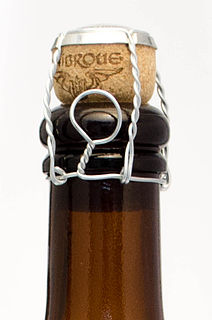 W
WA muselet is a wire cage that fits over the cork of a bottle of champagne, sparkling wine or beer to prevent the cork from emerging under the pressure of the carbonated contents. It derives its name from the French museler, to muzzle. The muselet often has a metal cap incorporated in the design which may show the drink maker's emblem. They are normally covered by a metal foil envelope. Muselets are also known as wirehoods or Champagne wires.
 W
WA naggin in Ireland is a 200ml bottle of spirits. Major brands of vodka, whiskey, rum, and less often gin, are commonly sold in this size in off licences, especially independent (non-chain) shops, typically at 37.5% to 40% ABV. Naggins are more common than half-bottles, though for the less popular majority of products neither size is available, only the 700 mL EU standard bottle size. The naggin bottle is typically the shape of a large hip flask, suitable for placing in a pocket.
 W
WNew Year's Bottles, or New Year's flasks, are an archaeological type of lentoid bottles found in the cultures of Ancient Egypt. These bottle were filled with water from the Nile, or possibly with perfume or oil, and offered as celebratory gifts for the New Year. Since the Egyptian New year began at the start of the flood season, offering water from the Nile was a way to symbolise the new cycle.
 W
WA plastic bottle is a bottle constructed from high-density or low density plastic. Plastic bottles are typically used to store liquids such as water, soft drinks, motor oil, cooking oil, medicine, shampoo, milk, and ink. The size ranges from very small bottles to large carboys. Consumer blow molded containers often have integral handles or are shaped to facilitate grasping.
 W
WA beer bottle is a bottle designed as a container for beer. Such designs vary greatly in size and shape, but the glass commonly is brown or green to reduce spoilage from light, especially ultraviolet.
 W
WThe pull-off bottle cap is a bottle closure that can be opened without any tools. It has a ring that can be pulled in order to detach the cap from the bottle. The cap splits along scores in the cap, therefore loosens and can be removed from the bottle. Drink companies use ring pull caps to differentiate themselves from competitors.
 W
WS'well is a reusable water bottle and insulated products company headquartered in Manhattan, New York. Sarah Kauss founded the company in 2010 and was the company's CEO until 2020.
 W
WSigg Switzerland AG is a Swiss manufacturing company with its headquarters in Frauenfeld. Sigg bottles are bottles designed and manufactured in Switzerland from aluminum and polypropylene or in China from stainless steel and glass. The company is famous because of the iconic shape its classic bottle and numerous designs which have led to its addition to the permanent design collection of the New York Museum of Modern Art.
 W
WA sipper water bottle is a type of bottle used to dispense water for certain pets including rabbits, ferrets, hamsters, chinchillas, gerbils, and other small animals. Typically a sipper bottle consists of a plastic portion used to contain the water, a plastic cap, and a metal tube with a ball bearing inside.
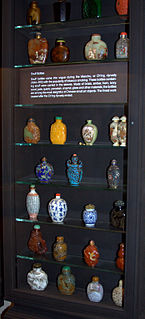 W
WSnuff bottles were used by the Chinese, Mongolians during the Qing Dynasty to contain powdered tobacco. Smoking tobacco was illegal during the Qing Dynasty, but the use of snuff was allowed because the Chinese considered snuff to be a remedy for common illnesses such as colds, headaches and stomach disorders. Therefore, snuff was carried in a small bottle like other medicines. The snuff bottle replaced the snuff box used by Europeans.
 W
WThe Speyer wine bottle is a sealed vessel, presumed to contain liquid wine, and so named because it was unearthed from a Roman tomb found near Speyer, Germany. It is considered the world's oldest known bottle of wine.
 W
WA spray bottle is a bottle that can squirt, spray or mist fluids. A common use for spray bottles is dispensing cool cleaners, cosmetics, and chemical specialties. Another wide use of spray bottles is mixing down concentrates such as pine oil with water.
 W
WA squeeze bottle is a type of container such as a plastic bottle for dispensing a fluid, that is powered by squeezing the container by exerting pressure with the user's hand. Its fundamental characteristic is that manual pressure applied to a resilient hollow body is harnessed to compress fluid within it and thereby expel the fluid through some form of nozzle.
 W
WStanley is an American brand of food and beverage containers invented by William Stanley Jr.
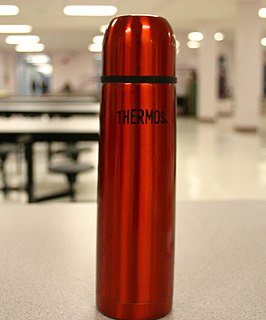 W
WA vacuum flask is an insulating storage vessel that greatly lengthens the time over which its contents remain hotter or cooler than the flask's surroundings. Invented by Sir James Dewar in 1892, the vacuum flask consists of two flasks, placed one within the other and joined at the neck. The gap between the two flasks is partially evacuated of air, creating a near-vacuum which significantly reduces heat transfer by conduction or convection.
 W
WThe two-liter bottle is a common container for soft drinks, beer, and wine. These bottles are produced from polyethylene terephthalate, also known as PET plastic, or glass using the blow molding process. Bottle labels consist of a printed, tight-fitted plastic sleeve. A resealable screw-top allows the contents to be used at various times while retaining carbonation.
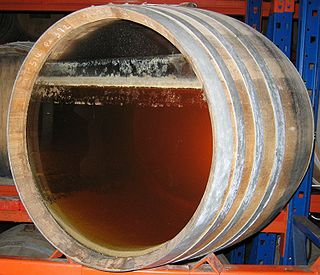 W
WUllage is a winemaking term that has several meanings but most commonly refers to the headspace of air between wine and the top of the container holding the wine. It can also refer to the process of evaporation that creates the headspace itself or it can be used as a past tense verb to describe a wine barrel or bottle that has gone through the evaporation process. The headspace of air is a mixture mostly of alcohol and water vapors with carbon dioxide that is a by-product of the fermentation process. In containers that are not completely air-tight, oxygen can also seep into this space. While some oxygen is beneficial to the aging process of wine, excessive amounts can lead to oxidation and other various wine faults. This is why wine in the barrels is regularly "topped up" and refilled to the top with wine in order to minimize the head space. In the bottle, the ullage or "fill level" of the wine can be an important indicator of the kind of care and storage conditions that the wine was kept in. After-market resellers and wine auction houses will often inspect the ullage levels of older vintages to determine the potential quality and value of wine.
 W
WA wash bottle is a squeeze bottle with a nozzle, used to rinse various pieces of laboratory glassware, such as test tubes and round bottom flasks.
 W
WA water bottle is a container that is used to hold water, liquids or other beverages for consumption. The use of a water bottle allows an individual to drink and transport a beverage from one place to another.
 W
WA waterskin is a receptacle used to hold water. Normally made of a sheep or goat skin, it retains water naturally and therefore was very useful in desert crossings until the invention of the canteen. It is still used in some developing nations. Though it may have been used over 5000 years ago by tribal peoples, the first pictures of it are from ancient Assyrians, who used the bladders as floats in 3000 B.C. It also was used by large ancient empires such as Rome before the advent of the canteen.
 W
WA wineskin is an ancient container made of animal skin, usually a goat, used to transport liquids such as water, olive oil, milk, wine, butter or even cheese.